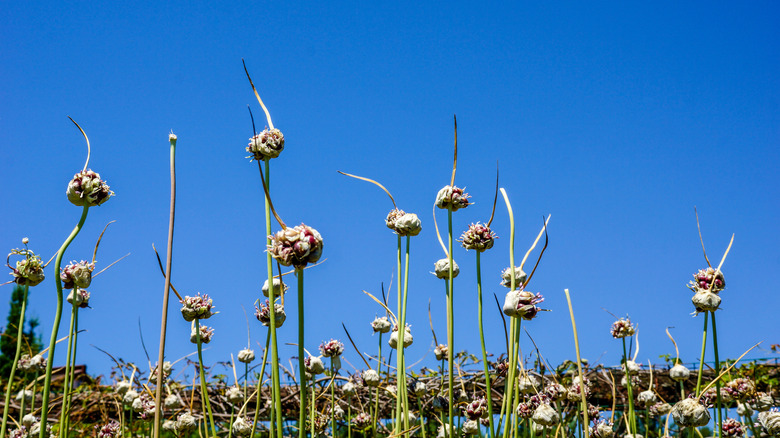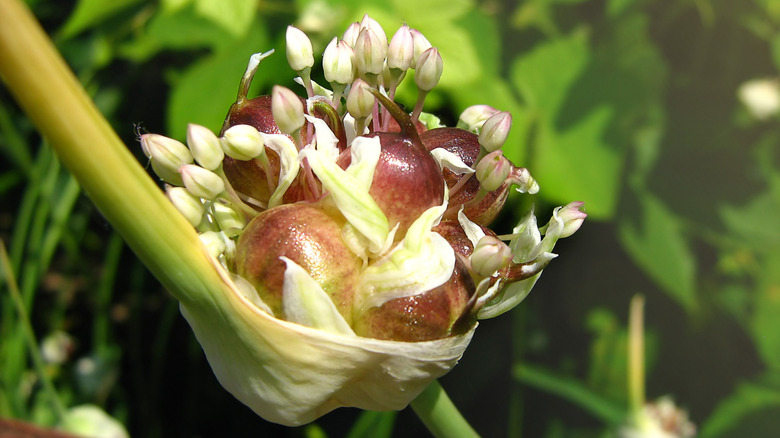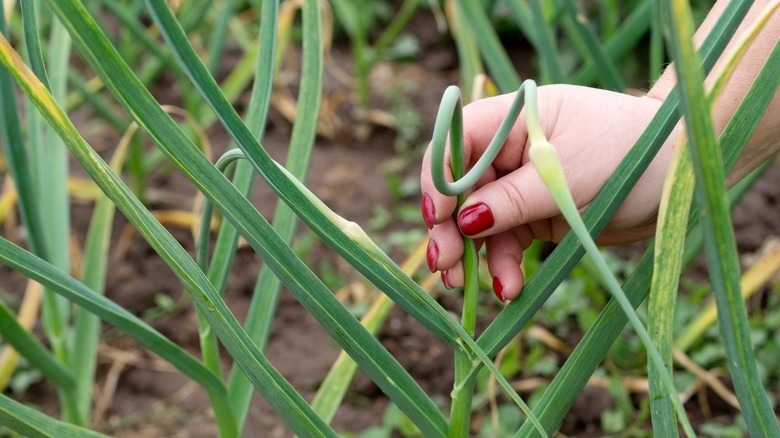Here's Why Your Garlic Plants Are Flowering (& What To Do About It)
You think you have everything you need to know to grow your own garlic down pat. Then, all of a sudden, long, bulbous-ended flower stalks start exploding from the plants in your garlic patch. Garlic can flower? Well, not quite. What you're seeing is a scape, and it means you'll soon be harvesting your bulbs. However, getting the big bulbs of your green-thumbed dreams will only happen if you chop that scape off. Bonus: The scapes are edible, too. If you actually see flowers in the traditional sense, chances are you're growing a garlic relative — for example, elephant garlic, which is actually a leek, not a garlic, and boasts big purple blooms.
The scape pops out of the plant around a month after the plant starts to create a bulb. Despite the use of the word "flower," garlic plants will never actually bloom in the traditional sense, nor will they produce seeds — at least where commercial cultivars are concerned, and that's probably what you've planted because they're the most commonly available to home growers. Once mature, the bulbous end of the scape is full of tiny cloves, clones of the original plant, that are sometimes topped with sterile blossoms. They're plantable, by the way! So-called flowering is mostly only an issue with hard-neck garlic since soft-neck garlic doesn't grow a flower spike — hence why the "neck" or spot where the leaves grow from stays soft. (We say mostly because a few soft-neck cultivars sometimes put out flimsy flower spikes.)
Leave garlic scapes on or remove them?
Flowering garlic isn't actually a bad thing. Hard-neck garlic bulbs produce their dramatic flower stems simply because the various cultivars are more closely related to wild garlic, which has seed-producing flowers, than their soft-neck counterparts. In fact, leaving the scapes on a few plants gives you an easy way to know when your garlic is ready to harvest! (More on this later.) You can also plant the 4 to 12 mini cloves (the botanical name is bulbils) that form in the bulbous end of the scapes you left uncut. Just keep in mind that they take longer than bulb cloves — the ones that grow underground — to sprout.
However, removing the scapes from most of your garlic is best because, as we mentioned, you risk ending up with disappointingly small bulbs if you leave them on. Garlic grown from cloves takes a year or more to mature; you don't want to feel like you wasted all that time come harvest. The plant puts its energy into growing the 4 to 12 mini cloves in the flower head — it wants to nurture the next generation, after all — instead of deliciously large in-the-ground bulbs. The flower stems appear in the late spring to early summer. In some places, this process is called bolting. They start out sticking straight up from the middle of the plant and slowly curve around in a spiral or circle, hardening as the season progresses.
Buy the right garlic cultivars and avoid flowers
Cut the scapes off at the base when they're about 5 to 10 inches long and start bending around. Use sharp pruning shears or herb scissors to ensure a clean cut, keeping your garlic plant and bulb healthy. In fact, some experts advise pulling scapes instead of cutting them to reduce the risk of disease. Fertilize your garlic after scapes appear to ensure a bumper underground crop. However, don't use a nitrogen-heavy fertilizer; it might inhibit bulb growth. Once around a month has passed since snipping the scapes and half of the garlic plant leaves have died, you can dig up the bulbs.
If you want to avoid dealing with flowers altogether, grow soft-neck garlic varieties that don't produce scapes. Popular cultivars include Silverskin, Inchelium Red, California Early, California Late, Italian Late, Lorz Italian, French Red, and Rose Du Var. Likewise, pass over seed bulbs with Rocambole, Porcelain, and Purple Stripe on the label or cultivars like Spanish Roja, Montana Giant, German Red, Killarney Red, Chesnock Red, Metechi, Music, German White, Russian Giant, Penn Wonder, Merrifield Rocambole, Bogatyr, Korean, Dujanski, and Siberian. These are all hard-neck varieties; some are state or region-dependent and might not be available everywhere. This is one good reason why growing your own grocery store garlic could go wrong — it's tricky (possibly impossible?) to tell which variety you'll end up with.



